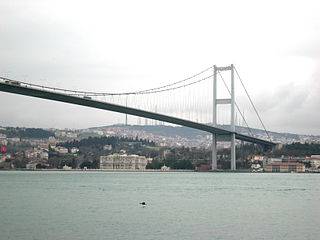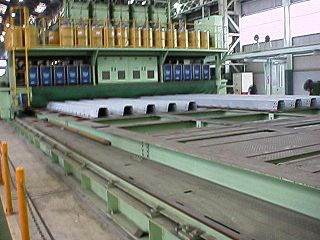
A bridge is a structure built to span a physical obstacle without blocking the way underneath. It is constructed for the purpose of providing passage over the obstacle, which is usually something that is otherwise difficult or impossible to cross. There are many different designs of bridges, each serving a particular purpose and applicable to different situations. Designs of bridges vary depending on factors such as the function of the bridge, the nature of the terrain where the bridge is constructed and anchored, and the material used to make it, and the funds available to build it.
A civil engineer is a person who practices civil engineering – the application of planning, designing, constructing, maintaining, and operating infrastructure while protecting the public and environmental health, as well as improving existing infrastructure that may have been neglected.

The American Society of Civil Engineers (ASCE) is a tax-exempt professional body founded in 1852 to represent members of the civil engineering profession worldwide. Headquartered in Reston, Virginia, it is the oldest national engineering society in the United States. Its constitution was based on the older Boston Society of Civil Engineers from 1848.

Henry Petroski is an American engineer specializing in failure analysis. A professor both of civil engineering and history at Duke University, he is also a prolific author. Petroski has written over a dozen books – beginning with To Engineer is Human: The Role of Failure in Successful Design (1985) and including a number of titles detailing the industrial design history of common, everyday objects, such as pencils, paper clips, toothpicks, and silverware. His first book was made into the film When Engineering Fails. He is a frequent lecturer and a columnist for the magazines American Scientist and Prism.
Structural health monitoring (SHM) involves the observation and analysis of a system over time using periodically sampled response measurements to monitor changes to the material and geometric properties of engineering structures such as bridges and buildings.

An orthotropic bridge or orthotropic deck is typically one whose fabricated deck consists of a structural steel deck plate stiffened either longitudinally with ribs or transversely, or in both directions. This allows the fabricated deck both to directly bear vehicular loads and to contribute to the bridge structure's overall load-bearing behaviour. The orthotropic deck may be integral with or supported on a grid of deck framing members, such as transverse floor beams and longitudinal girders. All these various choices for the stiffening elements, e.g., ribs, floor beams and main girders, can be interchanged, resulting in a great variety of orthotropic panels.

Deformation monitoring is the systematic measurement and tracking of the alteration in the shape or dimensions of an object as a result of stresses induced by applied loads. Deformation monitoring is a major component of logging measured values that may be used to for further computation, deformation analysis, predictive maintenance and alarming.

Robert James Mair, Baron Mair, is a geotechnical engineer and Emeritus Sir Kirby Laing Professor of Civil Engineering and Director of Research at the University of Cambridge. He is Head of the Cambridge Centre for Smart Infrastructure and Construction (CSIC). He was Master of Jesus College, Cambridge, from 2001 to 2011 and a Fellow of St John's College, Cambridge from 1998 to 2001. In 2014 he was elected a vice president of the Institution of Civil Engineers and on 1 November 2017 became the Institution's president for 2017–18, its 200th anniversary year. He was appointed an independent crossbencher in the House of Lords in 2015 and is currently a member of its Select Committee on Science and Technology.
Dust Networks, Inc. is an American company specializing in the design and manufacture of wireless sensor networks for industrial applications including process monitoring, condition monitoring, asset management, Environment, Health and Safety (EHS) monitoring and power management. They were acquired by Linear Technology, Inc in December 2011, which in turn was acquired by Analog Devices, Inc in 2017. The Dust Networks product team operates in the IoT Networking Platforms group of Analog Devices.
Civionics is the combination of civil engineering with electronics engineering, in a manner similar to avionics and mechatronics. An emerging discipline, the main application area of civionics is currently the use of electronics for structural health monitoring (SHM) of civil structures, particularly photonics.

The Telford Medal is a prize awarded by the British Institution of Civil Engineers (ICE) for a paper or series of papers. It was introduced in 1835 following a bequest made by Thomas Telford, the ICE's first president. It can be awarded in gold, silver or bronze; the Telford Gold Medal is the highest award the institution can bestow.
Thomas Denis O’Rourke is an American educator, engineer and serves as the Thomas R. Biggs Professor, Civil & Environmental Engineering at the College of Engineering, Cornell University. Professor O’Rourke took his Bachelor of Science in civil engineering at Cornell's engineering college in 1970 and his doctorate at the University of Illinois at Urbana-Champaign in 1975.
Dan Mircea Frangopol is an American civil engineer and the inaugural holder of the Fazlur R. Khan Endowed Chair of Structural Engineering and Architecture at Lehigh University, Bethlehem, Pennsylvania.
The Illinois Structural Health Monitoring Project (ISHMP) is a structural health monitoring project devoted to researching and developing hardware and software systems to be used for distributed real-time monitoring of civil infrastructure. The project focuses on monitoring bridges, and aims to reduce the cost and installation effort of structural health monitoring equipment. It was founded in 2002 by Professor Bill F. Spencer and Professor Gul Agha of the University of Illinois at Urbana–Champaign.
The Journal of Structural Engineering is the principal professional peer-reviewed journal of the American Society of Civil Engineers, the oldest professional civil engineering society in the United States. The journal is one of the flagship journals of the Society. It is sponsored by its division, the ASCE Structural Engineering Institute.

Medhat Haroun was an Egyptian-American expert on earthquake engineering. He wrote more than 300 technical papers and received the Charles Martin Duke Lifeline Earthquake Engineering Award (2006) and the Walter Huber Civil Engineering Research Prize (1992) from the American Society of Civil Engineers.
Giatec Scientific Inc. is a Canadian-based company with headquarters located in Ottawa, Ontario. It is a developer and manufacturer of nondestructive testing quality control and condition assessment devices for the construction industry.
Eleni Chatzi is a Greek civil engineer, researcher, and an Associate Professor and Chair of Structural Mechanics and Monitoring at the Department of Civil, Environmental and Geomatic Engineering of the Swiss Federal Institute of Technology in Zurich.

Satish Nagarajaiah is an Indian-American academic professor, who teaches and conducts research in the departments of civil engineering and of mechanical engineering at Rice University. He was elected in 2019 to the United States National Academy of Inventors. He got elected in 2021 as Distinguished Member of American Society of Civil Engineers for achieving eminence in structural engineering, in 2017 as fellow of the American Society of Civil Engineers, and in 2012 as fellow of ASCE's Structural Engineering Institute. He has been honored with the 2020 Nathan N. Newmark Medal, 2017 Reese Research Prize, 2015 Leon S. Moisseiff Award from the ASCE. He is considered an authority in seismic isolation and adaptive stiffness structural systems and is known for his contributions to structural engineering.








